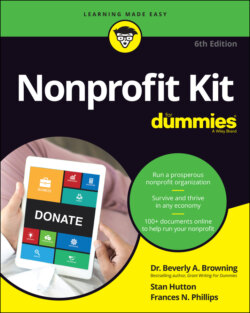Читать книгу Nonprofit Kit For Dummies - Stan Hutton, Beverly A. Browning - Страница 37
Being accountable and transparent
ОглавлениеAlthough nonprofit organizations aren’t public entities like government agencies and departments, their tax-exempt status — and the fact that contributions are tax-deductible — require them to be more accountable and transparent to the public than a privately owned business is.
It takes only a few media reports about excessive salaries or concerns about how a nonprofit has spent donated funds to prompt donors, legislators, or the general public to begin asking questions regarding the nonprofit’s finances and management. An IRS tax-exempt, 501(c)(3) nonprofit organization is required to be transparent and open in all of its operations and transactions.
A few nonprofit organizations have taken on the task of collecting information about other nonprofits and sometimes rating them in various categories so that prospective donors can use this information to help them choose which organizations to support. Charity Navigator (www.charitynavigator.org), CharityWatch (www.charitywatch.org), GuideStar by Candid (www.guidestar.org), and the Better Business Bureau Wise Giving Alliance (www.give.org) are four prominent organizations providing information about domestic (US-based) nonprofit organizations. If you’re just starting out and your nonprofit is small, your organization us unlikely to be evaluated by one of these organizations; however, a new nonprofit should definitely create a profile on GuideStar by Candid. For small, early-on funding requests, foundation and corporate grant makers will look for your profile on this website. Be sure to update it annually.
The degree of operational transparency, financial stability, and program results in your organization can be put under scrutiny by anyone or any entity. The more transparent your nonprofit, the more likely it is to receive initial and ongoing funding support.
We discuss nonprofit disclosure requirements in more detail in Chapter 6, but at minimum, federal law requires that nonprofits file a report (Form 990, 990-N, or 990-EZ) every year with the IRS. The amount of detail required in the report depends on the size of the nonprofit organization. States have their own reporting requirements, so contact your appropriate state office to learn what’s required.
Most nonprofits with annual gross receipts equal to or less than $50,000 can file the 990-N; nonprofits with gross receipts less than $200,000 and assets less than $500,000 can file the 990-EZ. Nonprofits with gross receipts equal to or greater than $200,000 or assets equal to or greater than $500,000 must file the long form 990.
